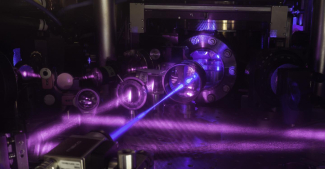JILA's three-dimensional (3-D) quantum gas atomic clock consists of a grid of light formed by three pairs of laser beams. Multiple lasers of various colors are used to cool the atoms, trap them in a grid of light, and probe them for clock operation. A blue laser beam excites a cube-shaped cloud of strontium atoms. Strontium atoms fluorescence strongly when excited with blue light, as seen in the upper right corner behind the vacuum window.
In an exciting turn for physics research, four major foundations have announced a collaborative funding effort for 11 pioneering "tabletop" experiments. The Gordon and Betty Moore Foundation, the Simons Foundation, the Alfred P. Sloan Foundation, and the John Templeton Foundation have come together, committing a total of $30 million. This unique initiative focuses on supporting experiments that, despite their relatively modest scale, are set to delve into areas often reserved for large-scale facilities.
Among the funded projects, each of which will receive up to five years of financial support, is a particularly notable experiment led by JILA and NIST Fellow Jun Ye and his research team. Known for his remarkable work in physics, Ye's project stands out for its ambition and innovative approach. The experiment involves the development of ultra-precise atomic clocks, which are expected to significantly advance our understanding of both quantum mechanics and general relativity.
Ye's project is designed to perform the first experiments where the effects of quantum mechanics and general relativity are both observable and measurable. This endeavor is about pushing the boundaries of atomic clock precision and conducting novel laboratory-scale tests that challenge and potentially expand the foundational principles of general relativity.
The significance of Ye's experiment cannot be overstated. It represents a crucial step in exploring the intersection of two fundamental but often separately studied aspects of physics. Moreover, the fact that this high-level research can be conducted on a "tabletop" scale exemplifies a shift in the paradigm of physics research, demonstrating that groundbreaking discoveries don't always require massive installations like particle colliders or telescope arrays.
This collective funding initiative underscores the Foundations' commitment to fostering innovative physics research. By pooling resources and expertise, they magnify the impact of their grantmaking and enable the exploration of uncharted territories in fundamental physics within the confines of a typical university lab.
Jun Ye's experiment, along with the other funded projects, offers profound insights into the mysteries of the universe, potentially paving the way for discoveries in physics. As these experiments progress, the scientific community eagerly anticipates the results, which could redefine our understanding of the physical world.
Written by Kenna Hughes-Castleberry, JILA Science Communicator




